Buckwheat is my new favorite topping for….everything! It’s no secret that I’m addicted to granola. Not so much the clusters or mix-ins but just the C.R.U.N.C.H. I love a variety of textures on my spoon at one time, and sprinkling granola on top of everything provides a satisfying chomp in every bite.
My very favorite granola is this Buckwheat Granola recipe that I got from the South Street Inn here in Charlottesville. When Matt and I visited on a house hunting stay, I fell in love, and they were so kind as to give me the recipe.
I have played with the recipe a bit and don’t do two-hour bake that they recommended in the original recipe. You can pretty much just add a cup of buckwheat to any granola recipe and you will have a super crunchy, higher protein granola!
So that’s the round-about way of telling you that I purchased a large bag of buckwheat from the Whole Foods bulk bins a few weeks ago and haven’t had the time to make a batch. So I just started using it plain.
Buckwheat Notes
Buckwheat is actually a fruit seed rather than a grain. The little kernels you see in the above jar are dry – yet they are edible and don’t need cooking or soaking to consume – sort of the same texture as Grapenuts. Toasted buckwheat is called kasha, but I just buy the basic groats. They look like little triangular nuts similar to wheatberries. They’re gluten-free as well.
You can blend the groats into flour, which I first learned about from the buckwheat bakes that Ashley made famous back in 2010 {see her complete list of buckwheat bakes here}. In my opinion, ground buckwheat tastes a bit like sand. So do the groats, really. And the bakes. It has a really earthy taste. Yet there is still something nutty and delicious about it – perhaps that it fills you up. But the groats are also super CRUNCHY which is why I love them. I haven’t ever tried cooking with them – but perhaps that’s a post to come.
Here is the nutrition information on a quarter cup of raw groats or 45 grams:
Buckwheat is high in protein + fiber, with plenty of carbohydrates for energy and barely any fat. According to World’s Healthiest Foods, a cup of cooked groats* is a very good source of manganese (34%) and a good source of magnesium (21%), copper (12%) and fiber (18%). And a complete protein to boot. *{Note due to the calorie difference I’m pretty sure the WH Foods information is for cooked groats.}
On My Plate
I didn’t make any buckwheat pancakes this week, but I’ve been enjoying the groats on breakfasts, lunches and dinners as a lower-sugar and fat version of granola and a lovely crunch topping for savory dishes.
Stirred into overnight oats
On cereal
On hot oatmeal
French toast!
Sprinkled throughout a salad
And on a mug of chili {loved the crunch here!}
How do you enjoy buckwheat?


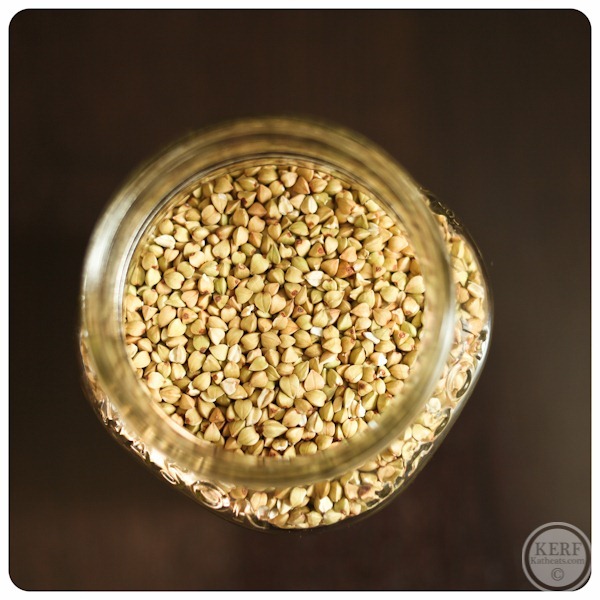
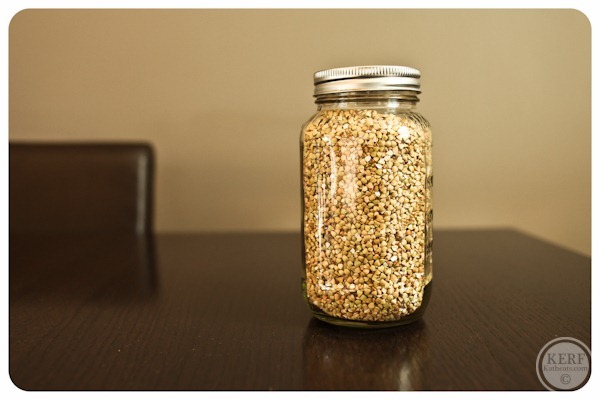

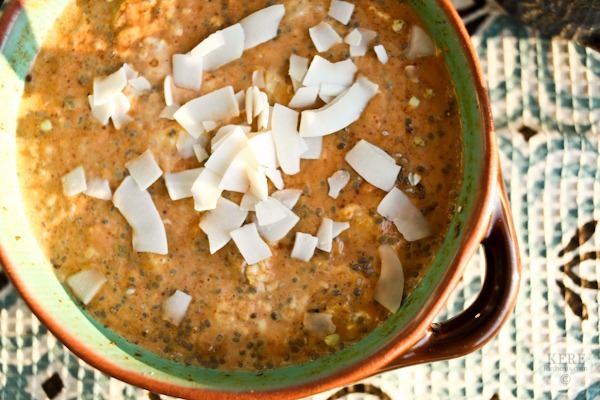
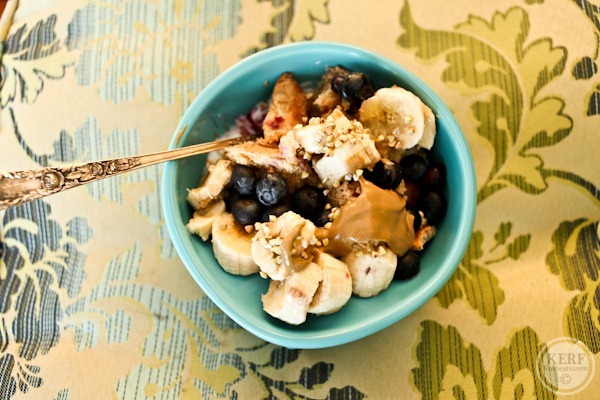
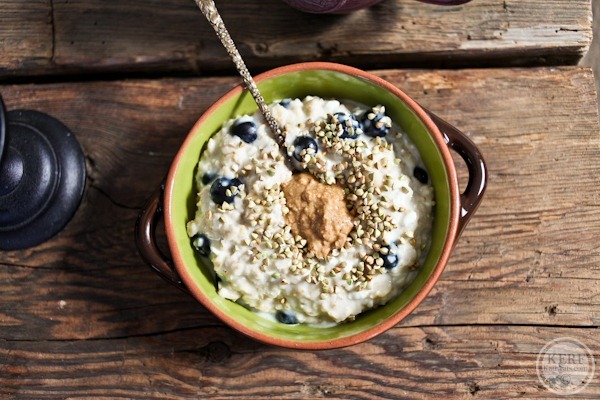
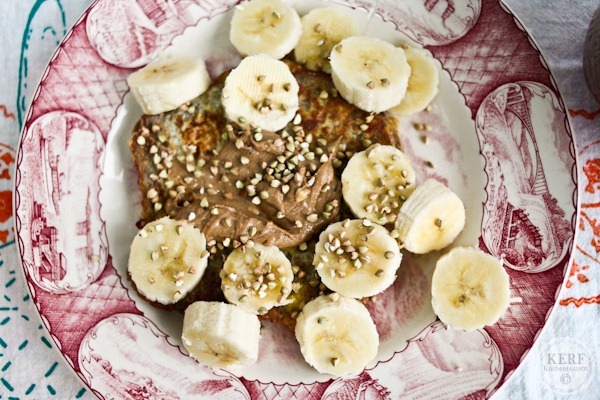
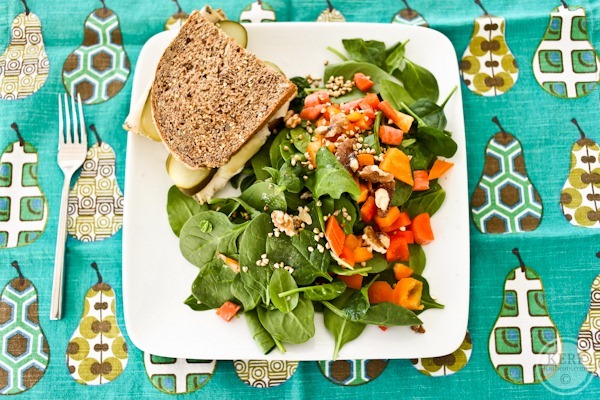
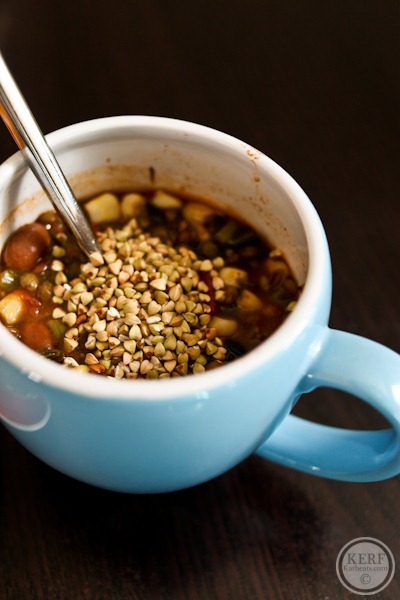
Ashley @ My Food 'N' Fitness Diaries says
Love the new header!
I don’t think I’ve ever even had buckwheat! This was a great post to learn more about it though. I had no idea it wasn’t a grain – interesting. Maybe I’ll have to give it a go one of these days!
Anele @ Success Along the Weigh says
I’ll be honest, I’ve never had it. Will have to make that one of my culinary goals this year!
Sara @ fitcupcaker says
How awesome only one gram of sugar!
Laura @ Sprint 2 the Table says
I choose one “good” carb to make for the week. On sunday I make a HUGE batch, but I don’t flavor it so I can change it up all week. Last week was quinoa… I’d forgotten about buckwheat! I love it – going to have to use it for this week’s batch.
Kelly @ Foodie Fiasco says
I absolutely love this idea, Laura! One night of cooking with a whole week of eating. May I borrow it?
Thank you so much for the buckwheat info, Kath!
Happycooksmiles says
I do one grain a week but freeze the rest, using some of previous weeks to bring variety in. Brown rice, quinoa, buckwheat, red rice etc, they all freeze well and are great to use as a base in a packed lunch salad.
I do the same with a different bag of pulses each week too… kidney beans , black beans, pinto, chickpea etc. Saves lots of time.
Hillary says
I’ve never made buckwheat on my own, but kasha was a staple growing up in a Jewish family. My cousins are currently putting together a cookbook of my great aunt’s most famous recipes, and I’m excited to get my hands on her kasha recipe and finally give it a shot!
Ray says
Same here. Kasha varnishkes is a common dish for Jews of Eastern European descent. My great aunt would make this dish all the time. Kath, I encourage you to try this. Although I can’t vouch for the taste if you omit the onions.
Elizabeth @ My Neon Running Shoes says
I have never had buckwheat! But my interest is sparked 🙂
Leslie says
Same here. I’ve never tried it but I’m ready to now. Thanks!
Sam says
Great post!
Katie @ Peace Love & Oats says
Um yea, definitely buying buckwheat now! And I love that it’s gluten free. Haha you’d assume not with the name, but I am so glad that it is! I’m hoping I can find it in my Whole Foods here in Chicago! I love the bulk section because I can try just a serving size or two, rather than a whole bag, to make sure I like it first!
Sami says
I bought some buckwheat groats awhile ago, and I had no idea what to do with them… they’re still sitting in the back of my pantry… now I know… you can do ANYTHING with them. They’re like nature’s sprinkles 🙂 Thanks Kath! Oh, and btw… do they ever “expire”? I’ve literally had them for over a year… ? haha.
KathEats says
They are probably a bit oxidized, but I would probably give them a pretty long shelf life. Maybe get some fresh ones : )
Victoria says
Like the new header! Very cute 🙂
I like buckwheat raw-nola! I bought it at a little restaurant in Philly it’s so crunchy!
Heather says
Love this type of post! I’ve never tried buckwheat but I’ve added it to my list of new foods to try! Thanks!
Joanne says
I like buckwheat but my favorite great grain is Spelt, especially when eaten in flake form and raw on top of yogurt or cottage cheese. It has a thick texture and loads of flavor even uncooked.
sassygirl711 says
spelt is good but NOT gf. ????
Lindsey @ Pas de Deux says
I like the new format! Especially the post title font – what is it?
I haven’t really used buckwheat much… I bought a bag of flour weeks ago, but it is still sitting in my freezer, unopened. BUT not two minutes before I read your post, I had just done a google search for buckwheat recipes! I think I’ll be making some kind of buckwheat flour banana bread this weekend, but I’ll also be picking up some groats next time I go to Whole Foods–thanks for the ideas on how to use it!
Shari says
Whoa! I just bought a cereal that has buckwheat, chia seeds, and hemp. I actually bought it for the chia seeds and really had no idea what the buckwheat is/was and now I do. 🙂 It says I can just add liquid and eat like that but I planned on topping oatmeal or other cereal with it.
Tracy says
Shari, is the cereal called Chia Goodness? I love that stuff! I use it in overnight oats a lot.
Shari says
It is called Q’ia and it was about half the price of buying just a bag of chia seeds, I will have to check out the Chia Goodness!
Ashley @ Coffee Cake and Cardio says
I have never used Buckwheat. Thank you so much for this post. I really love learning the nutritional values of foods. Love the new blog look too!
Lauren says
Kath – any way I can pin this article to my pinterest board? Am I missing it on your site? Thanks!
KathEats says
It should be at the bottom of the post before the comments
Hope says
Never had them. Thanks for the info! I also love crunch on my food. I’ll have to pick some up.
Katie @ Talk Less, Say More says
YUM! I don’t know if I’ve ever tried buckwheat before but you better believe I’m going to! This looks so good.
Kayla says
I’ve never tried buckwheat before but after this post I’m definitely trying some. I’m also the kind of person who likes the “crunch” factor with everything as well! Can’t wait to try these on top of overnight oats, oatmeal, and salads! I also love how you added a spoonful to soup! So creative…your simple ideas are always just so awesome! I just love your blog!
Carly @ Snack Therapy says
I’ve never tried it, but it’s good to know the little seeds are edible as they are! I’m also loving the new blog design!
Liz Dean says
Since we don’t eat gluten, we LOVE, love sprouted buckwheat waffles.
It’s my husbands favorite Sunday breakfast. He soaks and ferments them for 1.5 days. He then purees them in the food processor and it magically looks like waffle batter…we add eggs and whatever spices (cinnamon, nutmeg, pumpkin spice…etc)
So good!
Leah says
Totally not related to this post–but I tried the TJ’s smoked trout for lunch yesterday, and now I am hooked!!! It was so good on top of a salad! Do you eat the whole can for one meal?
KathEats says
Yep!
Ana says
Omg, I have to comment on this. My son loves sardines (and yes, he is 10!) and the other day we saw the smoked trout at TJ’s and bought it to try, it is so good!! I am not usually a big fan of smoked things (my son is though), and I liked it a lot!
Thanks for letting us know about the smoked trout. It is this kind of product tips and ideas that I like to see in your blog, along with your recipes and meal ideas/photos!!
Ana
tess says
i have to say, despite hearing for years how healthy these small fishies are for our health, i’ve been terrified of sardines! i was at TJ’s this week, and saw the smoked trout, but thought i’d start out with the sardines in spring water. dumped the whole can on a salad with black olives for dinner last night (the cat got the can juice and was in HEAVEN) and it wasn’t bad! i’ll admit, i didn’t LOVE it, and the black olives were my favorite part of the salad, but i’ll definitely have this a few times a month for a healthy and CHEAP meal!! what a wonderful example of eating healthy on a budget. thank you! smoked trout is up next! 🙂
KathEats says
Good for you! Perhaps a post on canned fish is next?
Kerry @ Totes My Oats says
I haven’t experimented much with buckwheat. But, like you, I like granola – a nice crunch with each bite. I may have to try this! Thanks for the idea!
Karen says
Buckwheat isn’t my favorite grain, but I do like the texture when cooked. I like farro, a very similarly textured grain a lot better – which has an even better nutritional profile and tastes better to my palate. I do soak my buckwheat overnight which removes the slime, and usually I toast it before cooking. I’m not sure I would digest the grain raw very well; it seems pretty tough to me.
Maureen says
I’ve never tried buckwheat before. Sounds interesting.
I am LOVING your new header!!
Shana says
You just inspired me to pick up some buckwheat tonight! I have never had the groats but I do love buckwheat flour pancakes. They are definitely more “earthy” which is why I love them for sandwhiches in place of bread (seems easier to digest too). Thanks for all of this awesome information about buckwheat!
Tina says
Never tried them out as something different as flour – I love buckwheat in cakes, waffles, and pancakes. Might be worth not grounding all from the next bag
Morgan says
I have yet to venture into buckwheat. Honestly, it really intimidates me because it always occurred to me that it was some kind of labor intensive grain. Now that I know differently, I think it’s time to take the leap.
T says
GREAT topic & post! Loving this kind of info right after the last (another great post w/tons of cutie Mazon, but less nutrition-related).
Sandrine says
Thanks for this post, I really learned a lot! And I really like the changes you made on your website front (the new fonts and all)! Keep up!
Jordan @ Eat for Health, Eat for Fun says
Are wheatberries a fruit seed as well? Can you add them plain to things or do they still need to be cooked?
KathEats says
They are a seed and definitely need to be cooked
Lea says
Curious… why do wheatberries need to be cooked, are you saying it’s because they’re a fruit seed? but buckwheat doesn’t need to be cooked?
(the section heading font size looks fine to me)
KathEats says
Because our teeth aren’t strong enough to chew them raw. But you certainly could eat them raw.
Becca says
I LOVE buckwheat flour. It works so well as a gluten-free flour replacement. I’ve had great success using it as a replacement for whole wheat or all-purpose flour. I use it weekly. I also make a lot of Ashley’s buckwheat bakes too 😛
joelle (on a pink typewriter) says
Love the new blog layout!
I’ve never tried buckwheat, but it seems so versatile!
Michael says
SUCH a fantastic post. Love the mix of description, photos, and nutrition info. I ADORE raw buckwheat on just about anything! Thanks Kath!
jen says
I love crunch too, so I’m very tempted by these little buckwheat nuggets. When you let them soak with overnight oats do they stay crunchy or lose their edge? And do they change the texture of the overall mix at all (like how chia seeds thicken it up a bit)?
I’ve only ever use buckwheat flour in pancakes, and you’re right, the flavor is very lovely and earthy.
KathEats says
They hold their crunch but not 100%. They didn’t change the texture.
Sarah says
Buckwheat pancakes are absolutely amazing! I’m not gluten free, but I actually prefer them to regular pancakes [much more texture+flavor].
Averie @ Averie Cooks says
add a cup of buckwheat to any granola recipe and you will have a super crunchy, higher protein granola! = GOOD TIP!
I havent used buckwheat in ages. Thanks for the reminder about this versatile ingredient!
Anna @ On Anna's Plate says
Hahaha…when I looked at that first picture, at first I thought it was a big jar of mini peanut butter chips! YUM!!! Buckwheat groats are not quite as exciting. 🙂
Love that pear placemat!
kylie @ immaeatthat says
I love them baked into banana bread or cookies! They stay slightly crunchy and are like little wannabe sugar granules:)
KathEats says
Good tip!
Ira says
I am Russian and it was a staple for me when I was growing up. We only cook toasted buckwheat (what you call “kasha” – although the word is of Russian origin, it is not what we call it, but it is besides the point) and it is normally cooked in water, nothing added, until fluffy and soft, much like you would cook quinoa. Then it is used as a side dish (like rice or quinoa) or breakfast (sweetened with some milk, etc, much like you use oats). I personally love it both ways. I have never heard of buckwheat kernels being used untoasted, much less raw, so it sounds super strange to me :), however, I do not think there is a “right” way or “wrong” way to eat something, so if you like it, go for it. Give cooked buckwheat a try (for best results cook toasted) as a side dish – it may surprize you.
Elaine says
I love the nutritional stats of buckwheat, but not sure I would like something that tastes like sand. I do like soba noodles though. Is the flavor similar?
KathEats says
Hmmm… Not so much because the texture is so different. Give them a try though!
Ana says
Nice post with info about buckwheat. I have tried it before and it does have a good crunch to it, sad thing is that both me and my son are allergic to it (yep, discovered it the hard way, by trying it out), and we both have gluten intolerance as well. So even though it is a gluten free seed, buckwheat is still not suitable for us.
Ana
Sarah says
this is so good to know! I literally bought a jar of buckwheat about a year ago thinking I would cook it into something, and it’s still sitting in my pantry. I had no idea that you could eat it raw – will try it on my oatmeal tomorrow! Also, that granola sounds delish.
Nina @ Too Hottie For That Body says
Before this post the only thing I knew about buckwheat was that he was a character from The Little Rascals… “O’Tay!” But you’ve got me sold on the edible version… I can’t wait to try it with my yogurt.
Shel@PeachyPalate says
I LOVE buckwheat! I buy Bob’s Buckwheat flour – makes amazing thick fluffy pancakes or buckwheat crepes! Also great for making cakes and muffins. I love the groats as a cooked grain in salads as well! Do you toast them before sprinkling? Makes all the difference 🙂
Kelly says
I love buckwheat in flour form as well. I’m pretty sure I get Arrowhead Mills version (I think) and I love it. I wasn’t sure when buying it if it would be overpoweringly earthy but I’ve actually found it to be milder than expected and have turned it into pasta and baked goods (sweet and savory) with good results.
I’m curious though about the description of ground buckwheat tasting like sand. Kath are you eating the ground buckwheat on its own or were you talking about its texture when cooked into things? I only ask because in using the flour I haven’t noticed any significant textural differences between that and whole wheat flour. But I guess it could also depend on if you’re grinding it yourself vs. buying flour at the store. I only mention this because I will admit if I hadn’t tried it and someone told me it tasted like sand I might be a bit skeptical, but with the flour I never noticed anything texturally unusual. In fact, if anything I like the texture it yields better than whole wheat flour. It’s especially fantastic in Pancakes like Shel says.
KathEats says
I think the cooked flour tastes a bit sandy in the bakes
Eating 4 Balance says
Love the new look of your site!
Tracy says
New header looks awesome!!
Love buckwheat groats and haven’t had them in forever. Just added them to my WF grocery list!
cathy says
I haven’t tried them but I also love crunch/texture in food, so I think I will. 🙂
Veronica says
My Eastern European grandmother makes buckwheat and potato holubtsi (stuffed cabbage). They are incredible dipped in sour cream (no tomato sauce like traditional stuffed cabbage).
Sarah says
Adding to grocery list. Because I’ve been abusing m granola privileges lately 😉
Lisa @bitesforbabies says
I’ve used buckwheat flour in a few recipes…don’t you find that it’s too hard (I mean, tooth-cracking hard!) to eat uncooked?!!
KathEats says
Not at all!
Lisa @bitesforbabies says
Maybe I should give it another chance then! 😉
lucy Lincoln says
been eating sprouted ‘bukwheaties’ (buckwheat groats) from a raw online food shop in uk for years now- also good is to make ‘rice crispy cakes’ out of them by mixing with coconut butter, dark chocolate and honey and setting in fridge into little crispy cakes, can flavour them with orange or peppermint extract. Also good is to soak them in yoghurt overnight and blitz them in blender and make pancakes with that batter. husband has laughed at me for years about my ‘buckwheat’s order’ arriving every few months!
Christine says
*gasp* what website do you get them from?? Sprouted ones are hard to find..
Miss Polkadot says
Thanks for the interesting post! I picked up buckwheat for the first time just about two weeks ago and haven’t used it a lot yet. During the past day, though, I’ve stirred a sprinkling of groats through my oatmeal before baking it. The slight chewy, crunchy texture it provided was a nice change.
I’m a bit hesitant about using it uncooked though. Is it really safe that way and pleasant to bite on?
Pam says
Hi Kath. I really like the new layout of your site.
But- the Budgeting link doesn’t work.
KathEats says
Thanks! I’ll fix it soon
bitt says
I love that buckwheat is usually gluten-free if not contaminated in the bulk bin. Just curious, why is the calorie count different for cooked than raw? And why does buckwheat sometimes come out whole on the other side of digestion? Any tips for that?
KathEats says
Because the volume is different when it’s cooked with water
Kori says
I love the changes that you’ve made to KERF! Very nice. I so want to add buckwheat to my daily eats now!
Tami@nutmegnotebook says
I really enjoyed this informative post! Unfortunately my daughter is allergic to buckwheat so we can’t have anything in the pantry with buckwheat in it. Even though she no longer lives at home I don’t want to accidentally use it in something I serve her. Buckwheat is in so many whole grain products these days we have to be so careful when shopping or eating out.
Katie @ SkinnyMinnieMoves says
Looks good on the chili! I love a crunch as well 🙂
Jenn says
Everything I have read says that to eat buckwheat groats raw you must first soak them. Is this not true?
KathEats says
I imagine this has to do with phytic acid, which can bind to certain minerals. Soaking reduces that effect, but it doesn’t mean you can’t eat it raw
Christina @ The Beautiful Balance says
I love buckwheat! I just think it is so underrated and needs more attention. 🙂
Lisa says
I have been so looking forward to this post Kath! I love buckwheat in my overnight oats and will try it sprinkled on salads. Last week I had brunch at my local cafe and it was organic caramelised activated buckwheat with mesquite goji berries sour cherries cacoa nibs coconut activated pecans, sunflower seeds and pepitas Incan berries agave and served with you choice of soy or fresh made almon milk. It was dinvine and Im sure you would love the crunchy textures!
Thanks again for this information and hope you continue with other health/superfoods. Kind Regards Lisa
KathEats says
Wow! Yum!
Laura Ann says
Love these crunchy guys! I put them on oatmeal and SIABs. 🙂
Ellie@Fit for the Soul says
I haven’t had it in a few months, but I love love buckwheat! Well for one thing, I love buckwheat noodles with a simple brothy Japanese sauce, garlic, wasabi, etc. And in terms of the actual buckwheat I love it in a baked ‘bread/cake’ form or in granola too–although I’ve had it in granola once and it was awesome like you said! I’m all about the different textures as well. 🙂
Stephanie @ Legally Blinde says
Great post, Kath! I’ve never tried buckwheat groats before, but I really liked learning about them. I also love granola but it’d be great to have a lower-sugar alternative. I think I’ll try them out!
Emily says
Yum! I have got to try! The weirdest topping to oatmeal, etc I’ve tried is flax seed!!! :/
Robin says
Good timing. I love buckwheat in things and I just bought some groats. I wasn’t sure if I could eat them as is!
Sarah (The Simple Dietitian) says
I am so intrigued by this and am now kicking myself for not purchasing some buckwheat at Whole Foods when I had the chance yesterday! No cooking time? No prepping? Just eating? Sign me up! 😀
Chelsea @ One Healthy Munchkin says
I like stirring buckwheat into my oatmeal too. But one of my favourite ways to eat it is in the buckwheat chia bread from the bakery cafe where I work. It’s fabulous!
Ella P says
Buckwheat is excellent for people with gluten intolerance.
When I lived in Russia I used to have grechnevaya kasha (????????? ????) for breackfast, so tasty and filling! I loved it so much that when I prepare it here (I live in Finland) I make sure my groats come from Russia!
Another super delicious and famous Russian dish is the blini, a buckwheat pancake topped with caviar, smetana (sour cream), chopped onion. That is something worth a try!
When I visit my parents-low-in Italy I often have pizzoccheri, a typical dish from the Norther part of Italy (Valtellina): a pizzocchero is a sort of short tagliatella made of buckwheat flour and then prepared with local cheese and vegetables.
Ella
Ella P says
Ops! I see the name in Cyrillic (in the brackets) has turned into question marks. Apologies.
lauren says
Great post! Love learning about not so common foods! thanks:)
Katie says
I don’t usually comment, but I just wanted to say that this was a great post! I have been reading your blog for a couple of years and its this kind of info that I look forward to the most. Thank you!
Emily J says
Hi Kath! I like this style of post! I sprinkle buckwheat on oatmeal sometimes, too.
Just a comment on the new fonts and things: the headings for the sections are a little on the small side for reading ease.
Thanks!
KathEats says
Hmm…not sure if I can easily change the size. I’ll search for a coding fix!
Emily J says
Thanks! You rock! 🙂
Angela says
pancakes! And I know it’s different, but I like my pancakes with some homemade jelly or sometimes a bit of maple syrup.
Tina B says
I’ve never had buckwheats. This was really informative! Thank you! I’ll have to give it a try.
Rosie says
Love this post Kath as I have a bag of Kasha from Bobs Red Mill in my pantry that I haven’t been sure what to do with. I will have to try your suggestions of just sprinkling them on yogurt, salads, oatmeal, etc. but you can really eat them raw? Love the granola recipe too so thank you.
Alyssa says
Kath,
I can honestly say I’m enjoying you blog even more now that you’ve switched up the content. I’ve been an avid reader – visiting multiple times per day since 2008, and although I’m not really a commenter, please know I’ve read everything and truly enjoyed it but lately for a while now, I felt like it was the same ol’ same old….
Until now! This new content, it’s refreshing! You have beautiful photographing and you’re insights into a balanced, healthy life are inspiring but the “hum-drum” of everyday eats began to lack content and real depth. You lost the knowledge you used to spread (during your nutritional days) and I feel that these new articles recapture that wealth of knowledge! I want to read a blog and learn something and I feel that these new posts offering knowledge and inspiration. They are only going to continually grow your blog, readership, and outside opportunities. Bravo for evolving and keep up the great work. I’ll be here reading, though probably silently, for years to coming!
robyn says
I’m really curious about you saying you don’t soak your raw buckwheat. This goes against anything I have ever read or had explained.
For example:
http://www.smallfootprintfamily.com/raw-buckwheat-granola
“When you prepare raw or traditional food dishes, you need to soak, rinse, drain and sprout all of your nuts, seeds and grains. This softens them, removes harmful enzyme inhibitors, and enhances their nutritional value prior to eating. By soaking and/or sprouting, you can eat buckwheat groats, wild rice, beans, and more without cooking them, which in turn maintains the natural enzymes and protects all of the protein, vitamins and minerals from being destroyed during heating.”
http://thenourishinghome.com/2012/03/how-to-soak-grains-for-optimal-nutrition/
“How to Soak Grains for Optimal Nutrition – Why Soak Your Grains?
In a nutshell, the centuries-old process of soaking grains, also known as culturing, helps to breakdown the antinutrients and hard-to-digest components of the grain and at the same time, helps to release highly beneficial nutrients.”
http://www.yumuniverse.com/2012/06/05/how-tosday-cooking-buckwheat/
“You should always soak buckwheat before preparing for optimal nutrient assimilation, but know that some health food stores carry already sprouted buckwheat, so give that a try if you are pressed for time.”
I’m just curious why you skip this step as everything I’ve found says the soaking process adds nutrition.
KathEats says
I don’t soak my oats either, and I’m not necessarily eating the buckwheat for nutrition alone.
Jenn says
Everything I’ve read implies that it’s also really hard to digest without first soaking it. If you are only eating it for the crunch and texture and not for the nutrition I see nothing wrong with that but when people ask if they should be soaked you might want to say “for optimal nutrition and the ability to properly digest maybe soak, but I prefer them crunchy and that’s why I eat them” or something to that effect! I am certainly not the blog police and only offer it as a suggestion not an order! There are things that I eat purely because I like the taste or the texture and the nutrition part doesn’t factor in so I see no harm in that. 🙂
robyn says
I guess I was hoping for a more nutritious / RD type of explanation – people devote blog entries to why they do so. I was just hoping to see more than a sentence of why you don’t. Not everyone here is being flippant or trying to “pull” something negative out of you. We genuinely want to learn how to eat better and the “why’s” behind it. It gets tiring constantly seeing brush-off replies like this. If not for nutrition, for what? Crunch alone? Texture? It’s ok to say why…and to back it up. That’s why you have the letters after your name!
KathEats says
I’m sorry for my quick response – I had been away from my computer all day and was answering a few comments before putting Mazen to bed. Despite being an RD, I am not immersed in nutrition research on a daily basis and to properly respond with an educated opinion on soaking grains, I would need to spend a few hours sorting through the research. As much as I would love to take the time to research this topic and give you a lengthy response, my objective with my new style of blogging was to spend less time at my computer, not more. I think you yourself advised me once to take a step back from the technology? KERF is not a nutrition blog, as my life has taken me down other paths. Maybe it will be someday when I again have the time to spend at the computer.
But to give you my quick answer: What I took away from 2.5 years of nutrition education is that most of the research that comes out still recommends a diet of whole, natural foods based on plants. The research I did on whole foods during my internship suggested that the more we learn about nutrition science, the more we realize eating food in its natural form is what leads to our best health and reduction of diseases. Isolated vitamin A is not better than a sweet potato. Until AND, the American Heart Association and doctors across America start telling everyone to make a change (like soaking grains), I’m going to consider the research either inconclusive or insignificant. Soaking grains may slightly increase nutrient absorption, but I don’t know if that’s really worth the trouble for most Americans when there is plenty of health benefits about grains without soaking. Not to mention reasons to eat them otherwise, such as flavor, texture, etc. (like raw oats in smoothies) Plus if you’re eating a balanced diet varied throughout the day, I imagine nutrient absorption is not a problem for healthy people. Hope that helps to answer your question.
robyn says
Thank you very much for the reply (or rather replies plural)! I didn’t expect an essay and I hope you realize that. But answering questions with non-answers are confusing. Again it’s balance – rather than feeling you have to rush an answer to every comment as it comes through, why not just publish it (or not) and once a week pull out 5-10 questions in your comments you feel you could go more in-depth in a reply to not only teach your readers, but possibly learn a bit more yourself. You could even post a reply to the effect, “I don’t have time to answer right now but I did receive this and I would like to come back to this more in-depth later…” if you can’t just publish it unanswered. Doing a comment Q&A day would fill one day of posting (pre-generated content provided by your readers and topics you’ve previously published on) and provide true answers rather than one-sentence rush-jobs. I’m not condemning your lack of time or how you choose to spend what you do have, and I hope you understand that. But imagine asking a serious question like that in a classroom setting and receiving that answer in return. If you’re here to learn, and want to do so, it’s very frustrating. The very core of your blog is that you eat real food and earned your RD — so when someone asks a very legitimate question “why does every site say they do it this way…” (when it only took me a few minutes rather than hours to confirm that and back that up), “…and you are the only one that says you do it differently, can you explain why in more detail?” — it’s not an overreach question. It’s “do you know more than I’m already able to find and research myself to do it that way”. Thanks again!
Verenique B says
so how much buckwheet is a good amount for just topping on oatmeal? mabye 2Tbs?
can take the place of adding nuts?
KathEats says
Yes – 1-2 tbsp.
Brooke says
Looks like I need I get my hands on some buckwheat!! Great pictures as well (:
Vava says
We grew up eating buckwheat – back in the USSR it was one of the most popular kashi. It was generally boiled, drained and eaten as garnish for meats, or mixed with mushrooms and grated carrots, or, as breakfast kashi, with chilled milk (my childhood utmost favorite – the combo of hot buckwheat and chilled milk is unique)!
I was so delighted to discover it here in the USA – and, since I got vegan, it became one of the top dishes on my list (at least 2-3 times a week). Back in the day it was boiled and drained, but we just keep it soaked in water on the counter overnight and in the morning it has exactly the same soft texture as boiled. But much healthier, keeping all the vitamins and minerals intact.
Dry buckwheat is too hard for my taste though, i have very sensitive gums (they get scratched even by dry granola 🙁 so unfortunately it’s not for everybody. I wish!)
Vava says
oh, another yummy way to eat buckwheat (not the healthiest though) was to add sunflower oil and sugar into the boiled and drained buckwheat. Just remembered, grandma was saying it was super healthy! 😀
Steve says
I’ve made buckwheat pancakes for 35 years, and when my grown up kids come home, they still ask for them. Used to get the Aunt Jemimah box mix (which includes wheat flour) but now I just use 100% buckwheat flour and omit the wheat flour, and make my own batter. It’s hard to top these (no pun).
wendy r. says
I am not sure that thanking you will be sufficient! You revolutionized breakfast in my house! I have oats every day (it’s what I love to start the day with), and now I have been adding a tablespoon of buckwheat to them and truly enjoying the texture and taste – thank you for broadening my horizons! And thanks for the laugh when hubby gave me a very strange look as I was intently examining the Whole Foods bulk section….
Charlie says
I just started my raw diet a few months back.
I really need some diversity.
Thanks
Ancy says
I just finished buckwheat pancakes
yes it felt like I had something sandy.
I’ll try the whole thing rather than flour.
Kirsten Fischer says
My kids eat raw buckwheat at least 4 times a week. I top their GF cereals with it. They love it. Ground well, it makes great flour for baking (bread, muffins, pancakes) as well. A staple in our home.
Sonya says
This was a really fun post – to learn something new! I’ve never tried the crunchy bits, but I have the flour. I have made buckwheat pancakes and crepes (King Arthur Flour Whole Grain Baking cookbook), and buckwheat biscuits (The Mixer Bible cookbook). I thought that they were all good, but my husband doesn’t like buckwheat, it turns out. I am especially addicted to the biscuits – mmmm, so fluffy and good! It just depends on if you like the particular taste. I do, and I love the way they look, too. I will just keep mixing up half-batches of those biscuits for myself, they are that good! If you haven’t had it, you might not like the taste (I supoooooose), but I’ve seen it in bulk at my natural foods store, so that would be an easy way to try it.
Joy Sisto says
I enjoy buckwheat naturally sweetened, after making the groats into a finer grind with a food processor, sort of like grits. I just made a naturally sweetened and gluten-free vegan buckwheat porridge with baked apples and cinnamon this morning. It was divinely delicious and I will be making as well as posting the recipe on my blog real soon! 🙂
I am always looking for new ways to use pseudograins! 🙂
Nadia says
Hey 🙂
I’m wondering, what happens to the fiber in buckwheat when putting it in a food processor? Since fiber in fruit gets destroyed when we make smoothies out of it……….
Thank you!!
Clara says
I cook buckwheat just like steaming rice with a 2 to 1 ratio. Before I cook it, though, I toast the groats in a bit of olive oil in a frying pan. So, for 1 cup of groats, I toast it in about .5 teaspoon of olive oil or grape seed oil. I don’t let it brown. I add the groats to the frying pan when the oil has heated up a bit and stir constantly just till it gets a kind of toasted smell– like a piece of whole wheat bread smells in a toaster.
If I’m cooking 1 cup of groats, I’ll be using 2 cups of water. I put the water in a saucepan, add .25 teaspoon of salt, bring it to a boil, add the groats, cover the pan, turn the heat down till the water is just simmering and cook for probably about 20 to 25 minutes. Turns out a nice, fluffy, dry cooked product that I can refrigerate and use for all kinds of things. Sometimes I take the cooked groats and add some taco seasoning and water and simmer it to make taco filling. It’s pretty good that way.
Sandra says
I am addicted to raw, sprouted buckwheat. It’s easy to make.
Rinse buckwheat and soak for 15-20 minutes. Then drain upside down. (Ideally use a sprouting jar top or a piece of fiberglass screen rubber-banded on top of a jar.) RInse and drain 2x a day. Rinse and drain 1x a day in refrigerator, where they grow very slowly. Beware, they rot easily but you will get the hang of it.
This makes a great chewy addition to any dish, as well as adding a creamy texture to blended food.